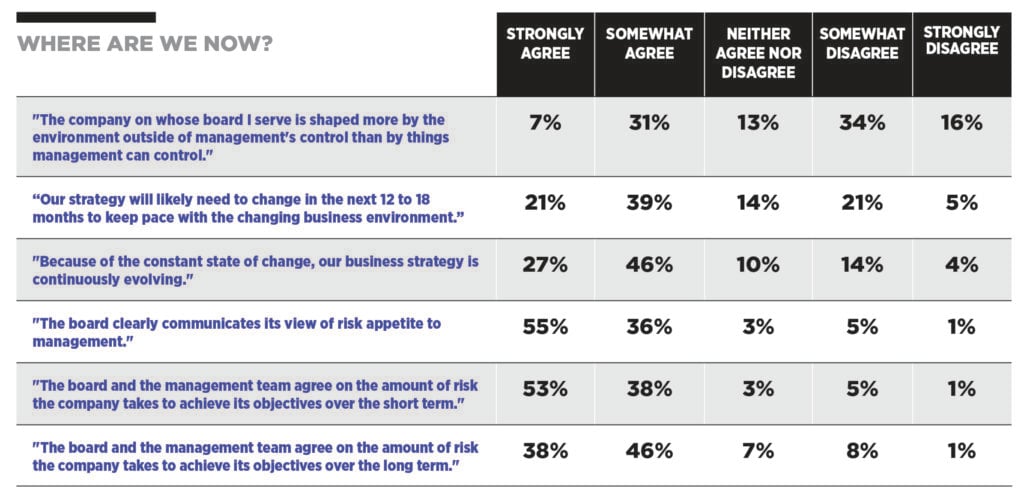The numbers underscore the extent to which talent concerns have escalated in boardrooms: The majority of U.S. public company boards now discuss workforce matters at least quarterly (58 percent), according to nearly 200 directors participating in our latest Corporate Board Member-EY Center for Board Matters survey. Another 24 percent say they do so at least twice a year.
That’s a significant jump from the 40 percent who, in 2020, said they discussed human capital regularly throughout the year. At that time, directors were already reporting an increase in board-level talent conversations, with 79 percent of directors saying the time their board spent discussing workforce matters had risen since 2015. The majority (69 percent) reported feeling that the frequency at which they were discussing the talent strategy at the time was “enough” to allow for adequate oversight.
The upswing in board focus on human capital in the past few years has been even more pronounced at larger companies. Among directors on the boards of companies with $10 billion in market cap or more, 78 percent report that they review human capital data quarterly vs. 22 percent at companies with a market capitalization of less than $300 million.
Despite investing significantly more time looking at people metrics, however, directors’ level of confidence in their understanding of employee sentiment and priorities has dipped, according to the survey results. Asked to use a scale where one is “strongly disagree” and five is “strongly agree” to rate whether their board has the insights it needs to understand the issues prioritized by employees, directors particating in our March survey overall gave an average of 3.6 out of five.
And when asked whether they agree that their board has a strong pulse on employee sentiment among frontline workers, that average ticked down to 3.2. One out of three said they strongly disagreed with that statement—and 8 percent said it didn’t apply because their board does not discuss data or insights related to the experience of employees.
In contrast, back in 2020, 78 percent of directors rated their board’s understanding of talent and workforce issues as “strong.” Eighty percent said their board’s understanding of employee experiences was excellent to adequate, and 61 percent said the same of their board’s understanding of the employee experience “at a granular level.”
So, what’s changed? For Bill Dozier, who serves on the board of Evolution Petroleum Corporation, the pandemic and the transition that followed are to blame. “Before that, everything was sort of in sync,” he says. “Then remote work started.”
While acknowledging that work-from-home policies provide flexibility, Dozier notes that remote work makes gauging employee satisfaction more difficult. “It’s real easy to disconnect when you work remote,” he says. “You still do your job, but you can disconnect from the work environment, from all the other people in the organization.”
This, he says, makes it challenging for management to get a good read on employee sentiment, which can then skew the data the board receives.
“The staying power of hybrid work and work-from-anywhere models, in combination with employees’ continued perceived power in the labor market, means companies may need a new approach to gauging sentiment,” says Kris Pederson, EY Americas Center for Board Matters leader. “For boards, this means asking how leaders are enabling employee engagement and how the office is becoming a destination for team-building and cultural experience.”
Ultimately, she says, boards need to question whether the company’s practices are attracting and retaining the talent they want.
Data quality can also be an issue. According to 43 percent of the directors we polled, management reports and company-sponsored surveys—which are the two most common methods of overseeing labor, according to 76 and 68 percent of directors polled—can contain misleading data because employees may not be fully honest in relating their true experiences and sentiments.
Questioning Candor
Lack of candor among employees participating in surveys is common, says James Treco, who serves on the board of Tonix Pharmaceuticals. There’s also a risk that boards are not getting the full picture from management. “I’m not sure, as a board member, you really understand the culture perfectly because you’re always getting filtered data,” he says. “I have frequent conversations with the CFO, but most of my contacts are with the CEO, so could I be managed? Absolutely. And I think gauging culture is difficult anyway, unless you actually work there. So, it’s very hard.”
Treco looks for opportunities to glean insights by engaging with the CEO both inside and outside the company. “As lead director, I encourage the other board members to reach out and have dinner with the CEO when you’re both in town. I think that’s a great way to get a sense for who the person is, and it gives you a vision for what they could be like. Because if you can build a relationship that is beyond just a formal board setting, and you can have casual conversations, you learn about his family and you exchange about your family, I think you can get a better measure of the person.”
In the end, directors need to build mutual trust with the management team, he says. “I don’t think as a board member you’ll ever completely understand the culture.”
Dozier agrees that overcoming bias completely may be impossible. However, boards can try to get around it, he says, noting that “specialized presentations,” whereby groups from different function areas inside the organization come to a board meeting to speak about what they’re working on and how it ties to the strategy can be useful. “You can do that through cross disciplines and get a feel for the top,” he says. “Is the discussion being too dominated? Do you have an individual who jumps in and won’t let any of their people talk? You sort of start finding those things out—are managers suppressing people?— stuff like that. When we start talking to people or have that dialogue, it enables us to pinpoint issues.”
Time With Talent
Time constraints, however, pose a challenge, according to directors. Half of those surveyed cited “competing priorities for the board’s attention/challenging schedules and limited time” as a top barrier to the oversight practices they deem most impactful, such as direct engagement with employees.
Dozier counters that boards simply need to commit to putting in whatever time is necessary to get talent oversight right. “If you’re a director, there should be time for everything that’s important,” he says. “So if that means the meeting needs to be eight hours or two days, then that’s the answer. You spend the time and don’t abbreviate things that are important.”
John Fluke, an independent director on the board of heavy-duty truck manufacturer Paccar, agrees. Whenever Fluke is traveling for business near one of his company’s plants, he makes a point of stopping by and arranging for a tour of the factory. “Of course, there’s a limit to how much you can disturb the company’s operations,” he says, “so if I’m out there poking around on the production floor, I’m mindful how much time I can demand of a worker and the extent to which I can disturb operations.”
“Direct employee engagement is particularly helpful for identifying and assessing any discrepancies between the messaging the board is getting from management and the actual employee experience,” adds Pederson. “EY research has uncovered that employees and employers often have divergent views on how companies are performing across key talent areas like wellbeing, flexibility, learning and skills. This is about deepening the board’s insight.”
Such worksite visits can also entail spending time in the employee lunchroom. “You sit down at a table with people, and you talk to them,” says Fluke. “And when you talk to them, the things you say should end in a question mark. You’re not there to tell them something. You’re there to ask them something. It’s an opportunity to talk to employees directly…. When you do this consistently with every single board meeting that you go on, you end up getting a feel for how things work.”
Diane Creel, who founded and served on the board of steelmaker TimkenSteel, an NYSE-listed company that changed its name to Metallus last February, also finds value in workplace visits. “What I always try to do is not ask specific questions but let them talk to me about the things that are on their mind,” she says. “Rather than direct the conversation, let them direct the conversation.”
This informal, conversational approach—which Creel argues needs be one-on-one rather than in front of several directors at once—helps employees let their guard down and speak more freely about what’s on their mind. “It’s all about how you communicate with them,” she says. “It’s not like you walk in, sit down and say, ‘I’m here to find out what you think it’s like to work at XYZ company.’ You say, ‘I’m here as a director. I’m trying to do a better job. Talk to me about things like how long you’ve been with the company, why you chose this company over another one, things you like, things you don’t like,’ that sort of thing.”
Creel uses those direct engagement opportunities to validate data provided in employee surveys and reports. “I like to take the engagement survey and try to read through it and understand what the employees are saying, and then use that as my background information in listening to the employee directly,” she says. “I will say that the things you get in engagement surveys are different than what you might hear in person, because I think they’re a little bit reticent to answer surveys a certain way, to write what they will tell you in person.”
OVERSIGHT VS. MANAGEMENT
In engaging with employees, directors need to exercise caution to avoid overstepping by veering from appropriate oversight into management, some survey respondents noted. Evan Behrens, a director on the board of Oppenheimer Holdings, says that respecting that line often requires the balance and tact that comes with experience. “If you don’t have somewhat of an ear to the grindstone, then you’re doing the company a disservice,” he notes. “But you have no right [as a board member] to go and seek that out on your own. It needs to be through management, and it needs to be impressed upon management that feedback from other people in a structured or in a managed format is necessary and required.”
However, he adds, “If you don’t think you’re getting objective data, that you are receiving information that is being filtered and managed, the question becomes, how to say, ‘I need more’? Because you’re not there to run the business.”
Demanding more human capital data may sound daunting, given that today’s boards are already reviewing a long list of items, with employee engagement and retention (67 percent), compensation (62 percent) and culture (60 percent) making up the top three most common metrics the board receives.
By comparison, four years ago, only 52 percent of directors reported overseeing employee engagement data, and 59 percent said they reviewed attrition metrics. At that time, 82 percent said that responsibility for compensation resided with the comp committee and not the full board.
Pederson says that a growing number of boards are expanding the purview of the compensation committee to allow the board to deepen its focus on talent. “The EY Center for Board Matters 2024 analysis of the charters of Fortune 100 compensation committees found that 79 percent now include broader human capital responsibilities related to the oversight of workforce-related matters, such as diversity, equity and inclusion, human capital, culture and employee engagement,” she notes.
MAKING AN IMPACT
One important finding from this year’s survey is the disconnect between how boards currently review human capital data and what they believe to be more impactful ways of doing so.
In order to gain insights into their workforce, for example, 76 percent of directors reported that their boards rely on presentations from the CHRO. Yet, only 58 percent of respondents rated CHRO presentations impactful. Meanwhile, just 24 percent of directors said they directly participate in listening sessions with employees. Yet, 45 percent dub such engagement impactful.
Similar gaps exist in oversight efforts related to culture. Currently, 68 percent of directors rely on whistleblower/hotline data to probe into the organization’s culture, but only 37 percent find that approach to be impactful—a gap of 31 points. A large gap was also evident between the use of legal claims and litigation data and director opinion on their usefulness, with 56 percent of directors reporting use of the data but only 28 percent rating it as impactful.
At the opposite end of the scale, 71 percent of directors rated engagement scores as impactful in overseeing culture, yet only 60 percent use them. Directors ranked engagement scores as the second most impactful way to assess culture among directors, right behind turnover and attrition metrics, including exit interview data (79 percent).
THE TRAINING OVERSIGHT
While few boards receive metrics on internal training, or on learning and development in general, according to our survey, several directors underscored development as a key element of human capital management. “People are first and foremost the driver of success at a company,” says Behrens. “If you don’t have the right people in the right positions, ultimately, you’re going to get very poor results. And people need to have opportunities in the company; they need to have opportunities to move up. If they’re not capable, then the board needs to understand why we can’t promote from within.
“If you’re meeting quarterly or five, six times a year and you’re meeting for a 6-to-12-hour board meeting, there’s at least an hour in there to discuss training because training is important in terms of providing opportunity and skills to people that are there, those that really want to be in your company and or grow or become better people. That’s how you retain and develop your best people.”
Training, Behrens says, is also an integral part of the talent acquisition strategy. “What skills do we need going forward, and how do we verify if we’re successful? You have to have some idea of what causes the problems or what advantages the company, or it will work its way through the system,” he says. “When the employees don’t have the requisite skills, you’re not going to get the requisite product or the efficiencies or the optimization of what you’re doing.”








